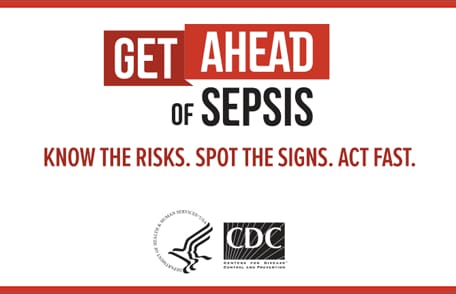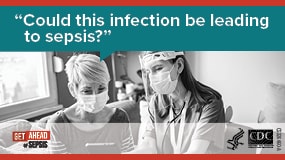Get Ahead of Sepsis – Know the Risks. Spot the Signs. Act Fast.

Read these stories to learn how these families were affected by sepsis.
Sepsis is a medical emergency. Sepsis can affect anyone, at any age, and regardless of whether someone has other medical conditions. If you or your loved one has an infection that’s not getting better or is getting worse, ACT FAST. Read these stories to learn how these families were affected by sepsis.
Infections can put you and your family at risk for a life-threatening condition called sepsis.
Anyone can get an infection, and almost any infection, including COVID-19, can lead to sepsis. Each year:
- About 1.7 million adults in America develop sepsis.
- At least 350,000 adults who develop sepsis die during their hospitalization or are discharged to hospice.
- 1 in 3 patients who dies in a hospital had sepsis during that hospitalization.
What is Sepsis?
Sepsis is the body’s extreme response to an infection. It is a life-threatening medical emergency. Sepsis happens when an infection you already have triggers a chain reaction throughout your body. Infections that lead to sepsis most often start in the lung, urinary tract, skin, or gastrointestinal tract. Most cases of sepsis start before a patient goes to the hospital. Without timely treatment, sepsis can rapidly lead to tissue damage, organ failure, and death.
The Get Ahead of Sepsis Educational Effort

It’s important that patients, their loved ones and caregivers, and healthcare professionals think about sepsis as a possibility. Get Ahead of Sepsis reminds these groups about the importance of sepsis prevention, early recognition, and appropriate treatment.
Anyone can develop sepsis, but some people are at higher risk for sepsis:
- Adults 65 or older
- People with weakened immune systems
- People with chronic medical conditions, such as diabetes, lung disease, cancer, and kidney disease
- People with recent severe illness or hospitalization, including due to severe COVID-19
- People who survived sepsis
- Children younger than one
A person with sepsis might have one or more of the following signs or symptoms:
- High heart rate or weak pulse
- Fever, shivering, or feeling very cold
- Confusion or disorientation
- Shortness of breath
- Extreme pain or discomfort
- Clammy or sweaty skin
People who might have sepsis should be urgently evaluated and treated by a healthcare professional
What Can Patients Do?
You can take specific steps to reduce your risk of sepsis, including sepsis caused by COVID-19, such as:
- Talk to your healthcare professional about steps you can take to prevent infections that can lead to sepsis, including:
- Take good care of chronic conditions
- Get recommended vaccines, since vaccinations prevent some infections, but do not cure sepsis
- Practice good hygiene:
- Wash your hands
- Keep cuts and wounds clean and covered until healed
- Know the signs and symptoms of sepsis. People who might have sepsis should be urgently evaluated and treated by a healthcare professional.
- Most people who develop sepsis have at least one underlying medical condition, such as chronic lung disease or a weakened immune system.
- Nearly a quarter to a third of people with sepsis had a healthcare visit in the week before they were hospitalized.
- Sepsis is a medical emergency. If you or your loved one has an infection that’s not getting better or is getting worse, ACT FAST. Get medical care IMMEDIATELY. Ask your healthcare professional, “Could this infection be leading to sepsis?” and if you should go to the emergency room.
What Can Healthcare Professionals Do?

As a healthcare professional you can:
- Know sepsis signs and symptoms to identify and treat patients early.
- ACT FAST if you suspect sepsis.
- Prevent infections by following infection control practices (e.g., hand hygiene, appropriate catheter management) and ensuring patients receive recommended vaccines
- Educate your patients and their families about:
- Preventing infections
- Keeping cuts and wounds clean and covered until healed
- Managing chronic conditions
- Recognizing early signs and symptoms of worsening infection and sepsis
- Seeking immediate care if signs and symptoms are present